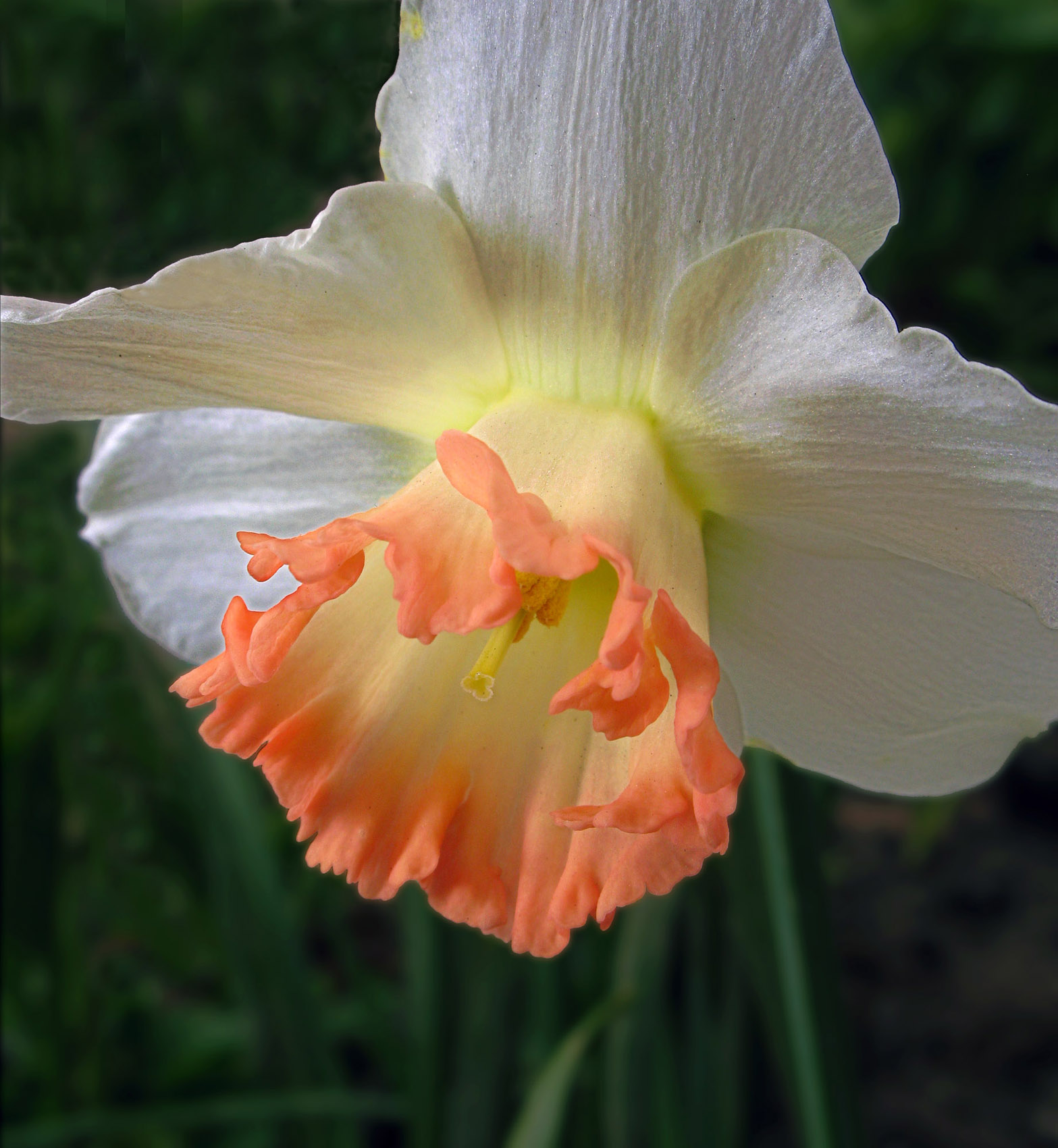|

Daffodil
(orange rimmed Narcissus)
Narcissus is the
botanic name for a genus of mainly hardy, mostly spring-flowering, bulbs
in the Amaryllis family native to Europe, North Africa, and Asia. There
are also several Narcissus species that bloom in the autumn. Though
Hortus Third cites 26 wild species, Daffodils for North American
Gardenscites between 50 and 100 excluding species variants and wild
hybrids. Through taxonomic and genetic research, it is speculated that
over time this number will likely continue to be refined.Daffodil
is a common English name, sometimes used now for all varieties, and is the
chief common name of horticultural prevalence used by the American
Daffodil Society. The range of forms in cultivation has been heavily
modified and extended, with new variations available from specialists
almost every year.
Etymology
There are two derivations of the name. One is that of the youth of Greek
mythology called Narcissus, who, in at least one of many variations of the
tale, became so obsessed with his own reflection as he kneeled and gazed
into a pool of water that he fell into the water and drowned. In some
variations, he died of starvation and thirst from just sitting by the edge
of the pool until he gave out, gazing at his reflection until he died. In
both versions, the Narcissus plant first sprang from where he died. The
other derivation is that the plant is named after its narcotic properties
(narkoa, to numb in Greek).
There are several plurals in common use:
"Narcissuses", "Narcissi", and "Narcissus". This last is common in
American English but is very rare in British usage. The American
Webster's Third New International Dictionary gives plurals in the
order "Narcissus", "Narcissuses", and "Narcissi", but the British
Compact Oxford English Dictionary lists just "Narcissi" and
"Narcissuses".
The name Daffodil is derived from an
earlier "Affodell", a variant of Asphodel. The reason for the introduction
of the initial "d" is not known, although a probable source is an
etymological merging from the Dutch article "de," as in "De affodil." From
at least the sixteenth century "Daffadown Dilly", "daffadown dilly", and "daffydowndilly"
have appeared as playful synonyms of the name.
The name jonquil is sometimes used
in North America, particularly in the southeastern United States, but
strictly speaking that name belongs only to the rush-leaved Narcissus
jonquilla and cultivars derived from it. In the southern United
States, narcissus are sometimes referred to as buttercups.
Description
All Narcissus species have a central trumpet-, bowl-, or
disc-shaped corona surrounded by a ring of six floral leaves called the
perianth which is united into a tube at the forward edge of the 3-locular
ovary. The seeds are black, round and swollen with hard coat. The three
outer segments are sepals, and the three inner segments are petals. Though
the traditional daffodil of folklore, poetry, and field may have a yellow
to golden-yellow color all over, both in the wild species and due to
breeding, the perianth and corona may be variously colored. Breeders have
developed some daffodils with double, triple, or ambiguously multiple rows
and layers of segments, and several wild species also have known double
variants.
Medicine
In kampo (traditional Japanese medicine), wounds were treated with
narcissus root and wheat flour paste, though it does not appear in the
modern kampo herb list. The Roman physician Aulus Cornelius Celsus listed
narcissus root in De Medicina among medical herbs, described as
emollient, erodent, and "powerful to disperse whatever has collected in
any part of the body". In one scientific study, the ethanol extract of the
bulbs was found effective in one mouse model of nociception,
para-benzoquinone induced abdominal constriction, but not in another, the
hot plate test.
One of the most common dermatitis
problems for florists, "daffodil itch" involves dryness, fissures,
scaling, and erythema in the hands, often accompanied by subungual
hyperkeratosis (thickening of the skin beneath the nails). It is blamed on
exposure to calcium oxalate in the sap.
Toxicity
All Narcissus varieties contain the alkaloid
poison lycorine, mostly in the bulb but also in the leaves .
Taxonomy
Kingdom: Plantae
Order: Asparagales
Family: Amaryllidaceae
Genus: Narcissus
from:
http://en.wikipedia.org/wiki/Daffodil
Photographic data:
Camera: Canon G9
Flash: Canon 430EXII with LumiQuest Bounce Kit (white)
iso 80, Aperture Priority at f/6.3, 1/100 second, focal length 12.73 mm
(macro)
ec= -0.33, fec= -2/3
Time shot: 10:32 AM on 3-15-2009 |
